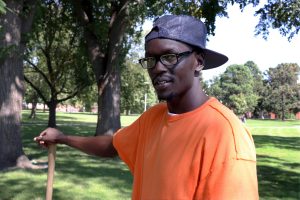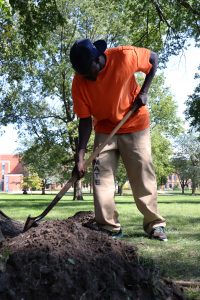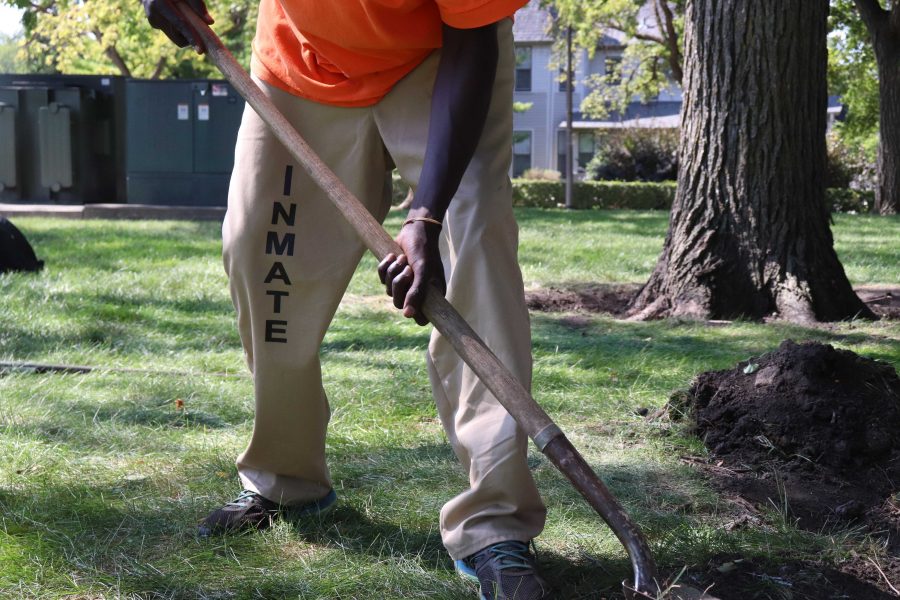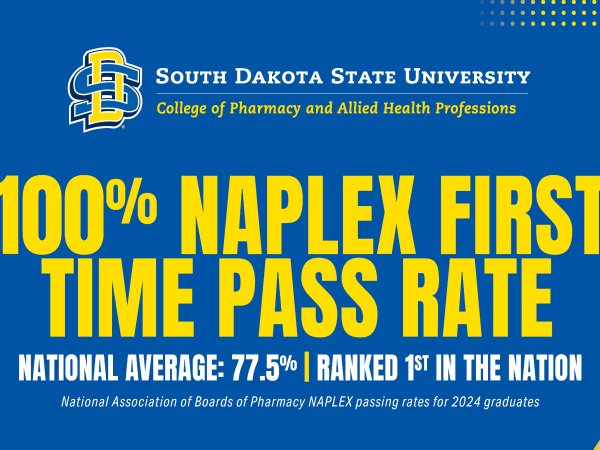They can be seen on campus working in maintenance and groundskeeping, from cutting trees and bushes to painting buildings and picking up litter. They are on campus from March to November and typically work Monday through Friday, from 7 a.m. to 4 p.m.
No matter where they are on campus, they are all dressed the same: orange shirts and tan khaki pants. The same word appears printed on their clothing. Across their backs and along their pants in large black letters, is the word, “INMATE.”
These are the inmates that serve SDSU as part of a community service program through the South Dakota Department of Corrections (DoC). They are all men, all from the South Dakota State Penitentiary in Sioux Falls and all set for release within the next five years.
One of these inmates is 27 year-old Domach Khai.

Domach Khai speaks about his time spent in school at Dakota State University. Khai was 22 years old when he was sentenced to 30 years in the men’s state penitentiary for first-degree robbery. (The Collegian, Ian Lack)
Khai was sentenced to 30 years in the South Dakota State Penitentiary for first-degree robbery in September of 2013. His sentence was commuted, and he said he will be released later this month.
“The work is alright,” Khai said. “It’s not hard and it definitely gives you something to do, to keep busy with. But it’s not something that I’ll put on a resume or nothing, but they give you a certificate.”
The program came to SDSU in 2008 under a physical plant services request from the university. There are an estimated 500 men and women in the community service program in the state. There are typically four to six inmates serving the SDSU campus at one time.
All of the inmates are minimum security prisoners, the lowest risk classification of inmates. The program bars inmates being held for more serious offenses like sexual assault. Most have been sentenced for a theft, drug or driving under the influence charge.
“They’re very integral to the campus environment because they do a lot of work with us, especially our landscape beds,” said Ryan Hoffman, a groundskeeper for SDSU. “There’s many hours that go into a lot of their work. They’re a big help.”

27-year-old Domach Khai, an inmate from the South Dakota State Penitentiary in Sioux Falls, digs up tree roots on the campus green to be treated. Khai performs service work like this often for his prison sentence, which will end this October according to Khai. (The Collegian, Ian Lack)
All of the inmates that are able to work — granted they meet medical and technical requirements — are required to work by South Dakota law, SDCL 24-4-7. The South Dakota Department of Corrections pays the inmates $0.25 per hour, while the DoC charges the university $1.25 per work hour.
Darwin Weeldreyer is the director of Community Services for the South Dakota Department of Corrections. Weeldreyer said the purpose of the program is to prepare inmates nearing the end of their sentences to re-enter the world and give them valuable work experience.
“We don’t pretend that they’re not inmates of the state of South Dakota. We’re just working to give these individuals an opportunity to work,” Weeldreyer said. “And we have partners that can stretch their budgets by using a lower-cost labor. At the end of the day, we’re just trying to give these guys and gals the chance to get some skill sets.”
Each fiscal year, the inmates collectively work 3,000 hours on the campus grounds. Each hour of service performed is overseen by an immediate-work supervisor, who works alongside the inmates and reviews their work.
Spencer Hardwood, vice president of Students’ Association, said students shouldn’t feel concerned with the presence of inmates working on campus.
“I would say you have to put your own faith in the South Dakota corrections system that the inmates working here are non-violent offenders, people serving short sentences,” Hardwood said. “They always have supervision as well.”
Khai is currently being housed at the Sioux Falls Community Work Center for inmates in the community service program. He said he’s looking forward to his release now, looking forward to getting back to “real work.”
“Oh yeah, I’m definitely excited to be getting out,” Khai said. “I want to get into commercial flying. I got to see if I can still get my pilot’s license.”
About his sentence, Khai said his five years behind bars have come at a “big cost” for his education and work outlooks.
“If I had known just how serious it was, I wouldn’t have gotten myself in trouble or gotten myself involved,” Khai said. “It was kind of one of those tunnel-vision things. I couldn’t see straight.”



















